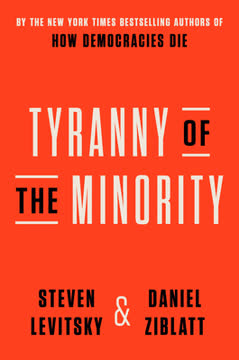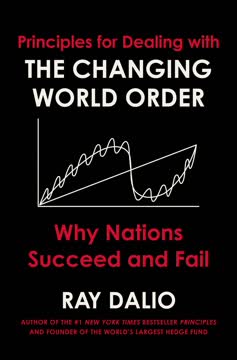Key Takeaways
1. China's education system produces high test scores but stifles creativity
"No one, after 12 years of Chinese education, has any chance to receive a Nobel prize, even if he or she goes to Harvard, Yale, Oxford, or Cambridge for college."
High scores, low innovation. China's education system is extraordinarily effective at producing students who excel on standardized tests like PISA. However, this success comes at a steep cost. The system's intense focus on test preparation and rote memorization leaves little room for developing creativity, critical thinking, and innovation.
Authoritarian roots. The current Chinese education model has its roots in the imperial examination system, which for centuries selected government officials based on their ability to memorize and interpret Confucian classics. This historical legacy emphasizes conformity and obedience over independent thought.
Creativity gap. Despite China's economic rise and growing technological prowess, the country has produced remarkably few Nobel Prize winners or groundbreaking innovations relative to its population size. This creativity deficit is increasingly recognized as a major challenge for China's future economic development and global competitiveness.
2. The imperial exam system shaped Chinese education for centuries
"All life's pursuits are worth less than [the] scholarly quest."
Keju's lasting influence. The imperial examination system, known as keju, was the primary method for selecting government officials in China for over 1,300 years. Its impact on Chinese education and culture cannot be overstated:
- Created a narrow definition of success focused on government service
- Encouraged intense competition and rote memorization
- Shaped cultural values around education and social mobility
Social control mechanism. Keju served as an effective tool for social control by the imperial government:
- Provided a path to power for commoners, reducing social unrest
- Ensured officials were well-versed in Confucian ideology
- Homogenized the educated class, limiting diversity of thought
Modern echoes. Although keju was officially abolished in 1905, its influence persists in modern Chinese education:
- Emphasis on high-stakes exams, particularly the gaokao (college entrance exam)
- Cultural pressure to excel academically at all costs
- Tendency to value memorization over critical thinking and creativity
3. China's economic rise came from loosening authoritarian control
"It was not foresight or wise planning by the central government that led to China's global rise. On the contrary, it was gradual withdrawal of government planning and regulation to create an environment that allowed people to exercise their autonomy."
Unintended consequences. China's economic miracle of the past few decades was not the result of top-down planning, but rather a pragmatic retreat from rigid totalitarian control. This loosening of restrictions unleashed the entrepreneurial spirit and productivity of the Chinese people.
Key reforms:
- Allowing farmers to sell surplus crops
- Permitting small-scale private businesses (getihu)
- Opening up to foreign investment and trade
- Granting more autonomy to state-owned enterprises
Balancing act. The Chinese government has struggled to maintain political control while allowing enough economic freedom to drive growth. This tension between authoritarian rule and market forces continues to shape China's development.
4. Chinese education reforms have struggled against cultural inertia
"China has launched a series of reforms over the past thirty years, from massive curriculum reform to governance and financing reforms, from textbook reforms to assessment reforms, and from reforming classroom practices to changing teacher preparation. It has even begun to tinker with the untouchable gaokao and college admissions."
Persistent challenges. Despite numerous reform attempts, the core of Chinese education remains largely unchanged:
- Intense focus on test preparation
- Excessive academic pressure on students
- Emphasis on rote memorization over critical thinking
- Narrow definition of success tied to exam performance
Cultural barriers. Deep-rooted cultural values and social expectations make meaningful reform difficult:
- Confucian emphasis on scholarship and social hierarchy
- Parental pressure for academic achievement
- Belief in effort over innate ability
- Fear of falling behind in a highly competitive system
Reform fatigue. Repeated attempts at reform have often led to superficial changes or unintended consequences, creating skepticism about the possibility of real transformation in the education system.
5. Intense academic pressure takes a toll on Chinese students
"This is the hell to heaven," one student said.
Grueling schedules. Chinese students, particularly in high school, face extreme academic pressure:
- 12-16 hour school days are common
- Limited time for sleep, exercise, or leisure activities
- Extensive homework and after-school tutoring
Psychological impact. The intense focus on academic achievement often comes at a high cost to students' mental health:
- High rates of stress, anxiety, and depression
- Low self-esteem and lack of confidence
- Limited development of social and emotional skills
Parental sacrifice. Many Chinese parents dedicate enormous resources to their children's education:
- Spending large portions of income on tutoring and test prep
- Relocating to areas with better schools
- One parent often quits work to focus on supporting their child's studies
6. PISA scores create an illusion of Chinese educational excellence
"The primary evidence that has been used to support the claim that Shanghai has an excellent education is its students' PISA scores in three subjects. Given the exam's technical problems and compared to the true purpose of a modern education, these scores are hardly evidence of greatness."
Narrow measure. PISA scores in math, reading, and science provide a limited view of educational quality:
- Ignore important subjects like history, arts, and physical education
- Don't measure creativity, critical thinking, or social-emotional skills
- Fail to capture the full range of talents and abilities students possess
Sampling issues. Questions have been raised about the representativeness of China's PISA sample:
- Only includes Shanghai, not a national sample
- May exclude migrant children and other disadvantaged groups
- Doesn't reflect the vast disparities in educational quality across China
Misplaced admiration. Western observers often mistakenly equate high test scores with overall educational excellence, ignoring the significant drawbacks of China's test-centric system.
7. Western admiration of Chinese education is misguided and dangerous
"Chinese education would be a poison for America, not a remedy."
Romanticizing authoritarianism. Some Western observers praise aspects of Chinese education that are fundamentally authoritarian:
- Strict discipline and obedience to authority
- Intense pressure to conform and perform
- Narrow focus on test preparation
Ignoring drawbacks. Admiration for China's test scores often overlooks serious problems:
- Lack of creativity and innovation
- High rates of student stress and burnout
- Widening educational inequalities
Misguided reforms. Attempts to emulate Chinese education in the West risk:
- Undermining creativity and critical thinking skills
- Increasing student stress and anxiety
- Narrowing the curriculum to focus on tested subjects
8. China needs innovation, not just high test scores, for future success
"China still trails many developed countries when it comes to real innovation and significant patents."
Economic transformation. As China seeks to move from a manufacturing-based economy to an innovation-driven one, its education system is proving inadequate:
- Produces excellent test-takers but few creative problem-solvers
- Emphasizes conformity over original thinking
- Lacks focus on entrepreneurship and risk-taking
Quantity vs. quality. While China has seen explosive growth in patents and research papers, the quality often lags behind:
- Many patents are low-quality or "junk" patents
- High rates of academic misconduct and plagiarism
- Few breakthrough innovations or Nobel Prize-winning discoveries
Brain drain concerns. China struggles to retain and attract top talent:
- Many of the best students study abroad and don't return
- Rigid education system discourages innovative thinkers
- Authoritarian political system limits academic freedom
9. True educational excellence cultivates diverse talents and creativity
"To cultivate the talents we need for the twenty-first century, we must redefine excellence in education. Instead of effectiveness in homogenizing students, an excellent education should support the development of diverse talents."
Paradigm shift needed. Both China and the West need to move beyond narrow definitions of educational success:
- Focus on cultivating creativity and innovation
- Encourage diverse talents and interests
- Develop critical thinking and problem-solving skills
Personalized learning. Future education systems should:
- Adapt to individual student strengths and passions
- Provide multiple pathways to success
- Balance academic knowledge with practical skills
Global perspective. Prepare students for an interconnected world by:
- Fostering cross-cultural understanding
- Developing language and communication skills
- Encouraging global collaboration and problem-solving
Last updated:
FAQ
What’s "Who’s Afraid of the Big Bad Dragon?" by Yong Zhao about?
- Critical look at Chinese education: The book examines why China’s education system is considered both the best and worst in the world, focusing on its high test scores and lack of creativity.
- Historical and cultural analysis: Yong Zhao explores how China’s imperial exam system and authoritarian governance have shaped its educational practices and outcomes.
- Global implications: The book warns against the global fascination with China’s test results, urging readers to consider the hidden costs and limitations of its system.
Why should I read "Who’s Afraid of the Big Bad Dragon?" by Yong Zhao?
- Debunks education myths: The book challenges popular beliefs about Chinese education, revealing the downsides of its test-driven, authoritarian approach.
- Cautionary tale for the West: Zhao warns Western countries, especially the U.S., about the dangers of emulating China’s high-stakes testing and conformity.
- Comprehensive perspective: Readers gain a nuanced understanding of global education trends, innovation, and the risks of sacrificing creativity for standardized success.
What are the key takeaways from "Who’s Afraid of the Big Bad Dragon?" by Yong Zhao?
- Authoritarian roots: China’s education system is deeply influenced by centuries-old traditions that prioritize obedience and conformity over creativity.
- Test scores ≠ excellence: High international rankings reflect rote memorization, not the cultivation of diverse talents or critical thinking.
- Innovation needs autonomy: Economic and educational innovation thrive when individuals have freedom, not under centralized, authoritarian control.
- Western emulation is risky: The U.S. and others risk losing their creative edge by adopting China’s test-focused model.
How does Yong Zhao explain the historical roots of China’s education system in "Who’s Afraid of the Big Bad Dragon?"?
- Imperial exam legacy: The keju system, lasting over 1,300 years, selected officials through rigorous exams on Confucian classics, rewarding conformity.
- Tool for social control: Emperors used exams to maintain power, channeling talent into memorization and loyalty rather than innovation.
- Lasting impact: This tradition still shapes China’s education, fostering compliance and discouraging independent thought.
What is the paradox of China’s education system being both the best and worst, according to Yong Zhao?
- Best in test performance: Chinese students excel in international assessments like PISA, showcasing strong academic skills.
- Worst in creativity: The same system suppresses individuality, intrinsic motivation, and innovation through conformity and rote learning.
- Systemic contradiction: The features that drive high scores also undermine broader educational and societal goals.
How does high-stakes testing, like the gaokao, shape Chinese education in "Who’s Afraid of the Big Bad Dragon?"?
- Central gatekeeper: The gaokao determines students’ futures, making it a high-pressure, high-stakes exam.
- Drives conformity and stress: The system leads to intense competition, frequent testing, and heavy academic burdens, often at the expense of genuine learning.
- Encourages cheating and inequality: High stakes incentivize unethical behavior and favor students with more resources, deepening social divides.
What are the key cultural values influencing Chinese education, as described by Yong Zhao?
- Narrow success definition: Traditional culture values government and scholarly achievement, sidelining other talents and professions.
- Hierarchy and ranking: Education is organized around constant ranking, reinforcing competition and conformity.
- Obedience and self-blame: Confucian values stress obedience to authority and self-blame for failure, discouraging questioning and creativity.
What is the "Fatal Attraction" or "prisoner’s dilemma" in education reform discussed by Yong Zhao?
- America’s test obsession: Zhao calls the U.S. pursuit of high test scores a "fatal attraction" that undermines educational values and encourages cheating.
- Mutual distrust in reform: In China, students, parents, and teachers want less testing but fear losing out if others don’t follow, perpetuating the status quo.
- Superficial compliance: Even with government orders, local officials often maintain existing practices, making real reform difficult.
Why does Yong Zhao argue that China struggles to produce breakthrough innovations despite its education system?
- Wishful thinking: The system starts with grand visions but lacks realistic understanding of what true innovation requires.
- Upward accountability: Hierarchical pressure leads to superficial compliance and cheating to meet unrealistic targets.
- Quantity over quality: Emphasis on measurable outputs like patent counts results in low-quality, sometimes fraudulent, research and inventions.
What are the consequences of the authoritarian approach to education highlighted in "Who’s Afraid of the Big Bad Dragon?"?
- Suppression of creativity: Emphasis on obedience and uniformity stifles curiosity, passion, and innovative thinking.
- Widespread cheating: Unrealistic demands lead to plagiarism, falsification, and low-quality academic output.
- Social and mental health costs: Intense competition causes stress, anxiety, and even suicides, while deepening social inequality.
What reforms does Yong Zhao suggest for improving Chinese education and fostering creativity?
- Decentralize admissions: Allow institutions to select students, creating multiple pathways to success and reducing competition.
- Grant institutional autonomy: Schools and universities should govern themselves, fostering diversity and reducing corruption.
- Diversify curriculum control: Relinquish government control over curriculum to enable innovative, student-centered learning experiences.
What warnings does Yong Zhao give to Western countries about emulating China’s education system in "Who’s Afraid of the Big Bad Dragon?"?
- Illusion of excellence: High test scores do not equate to comprehensive educational quality or creativity.
- Authoritarian costs: The features that drive test success also suppress individuality, creativity, and social-emotional development.
- Need for paradigm shift: Western education should prioritize creativity, diversity, and student-driven learning over test-focused, employee-oriented systems.
Review Summary
Who's Afraid of the Big Bad Dragon? receives mixed reviews, with an average rating of 3.92/5. Readers appreciate Zhao's historical context and critique of China's education system, praising the insights into standardized testing's limitations. Some find the book repetitive and simplistic, while others consider it a must-read for educators. Critics note the author's agenda against standardized testing and authoritarian education models. The book's exploration of China's cultural and political influences on education is generally well-received, though some desire more comparative analysis with other systems.
Similar Books










Download PDF
Download EPUB
.epub digital book format is ideal for reading ebooks on phones, tablets, and e-readers.




